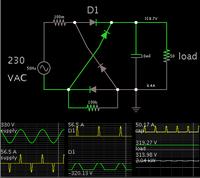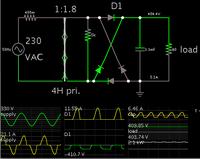nalawade
Junior Member level 2
I want to make a full wave diode bridge rectifier whose output voltage should be Dc 400 volts.
I will be supplying it from the single phase 230 V 50 Hz Ac supply.
At the load side I will be connecting a Full bridge inverter circuit which will get dc supply of 400V from the diode rectifier.
The maximum output of the inverter should be 2kWatts.
Which diodes should I use?
How do I select the components for the diode rectifier circuit?
which transformer to use. what should be its ratings?
how to calculate the value of filter capacitor which will be between inverter and rectifier?
I will be supplying it from the single phase 230 V 50 Hz Ac supply.
At the load side I will be connecting a Full bridge inverter circuit which will get dc supply of 400V from the diode rectifier.
The maximum output of the inverter should be 2kWatts.
Which diodes should I use?
How do I select the components for the diode rectifier circuit?
which transformer to use. what should be its ratings?
how to calculate the value of filter capacitor which will be between inverter and rectifier?

